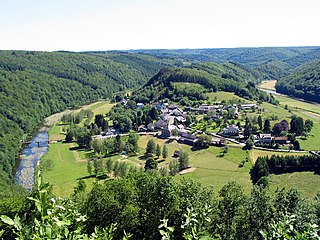
The Ardennes, also known as the Ardennes Forest or Forest of Ardennes, is a region of extensive forests, rough terrain, rolling hills and ridges primarily in Belgium and Luxembourg, extending into Germany and France.

Hainaut, historically also known as Heynault in English, is the westernmost province of Wallonia, the French-speaking region of Belgium.

Charleroi is a city and a municipality of Wallonia, located in the province of Hainaut, Belgium. It is the largest city in both Hainaut and Wallonia. The city is situated in the valley of the Sambre, in the south-west of Belgium, not far from the border with France. By 1 January 2008, the total population of Charleroi was 201,593. The metropolitan area, including the outer commuter zone, covers an area of 1,462 square kilometres (564 sq mi) with a total population of 522,522 by 1 January 2008, ranking it as the 5th most populous in Belgium after Brussels, Antwerp, Liège, and Ghent. The inhabitants are called Carolorégiens or simply Carolos.

La Louvière is a city and municipality of Wallonia located in the province of Hainaut, Belgium.
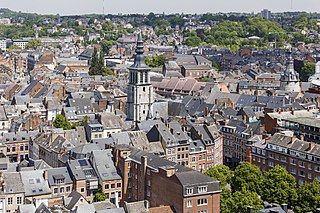
Namur is a city and municipality in Wallonia, Belgium. It is the capital both of the province of Namur and of Wallonia, hosting the Parliament of Wallonia, the Government of Wallonia and its administration.
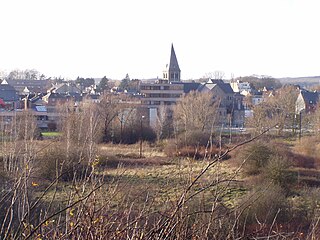
Sambreville is a municipality and since March 12, 2024 a Belgian city of Wallonia located in the province of Namur, Belgium.

Soumagne is a municipality of Wallonia located in the province of Liège, Belgium.

Visé is a city and municipality of Wallonia, located on the river Meuse in the province of Liège, Belgium.
Aiseau is a village of Wallonia and a district of the municipality of Aiseau-Presles, located in the province of Hainaut, Belgium.
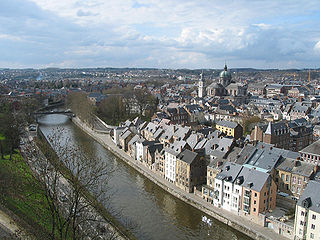
The Sambre is a river in northern France and in Wallonia, Belgium. It is a left-bank tributary of the Meuse, which it joins in the Wallonian capital Namur.
The history of Wallonia, from prehistoric times to the present day, is that of a territory which, since 1970, has approximately coincided with the territory of Wallonia, a federated component of Belgium, which also includes the smaller German-speaking Community of Belgium. Wallonia is the name colloquially given to the Walloon Region. The French word Wallonie comes from the term Wallon, itself coming from Walh. Walh is a very old Germanic word used to refer to a speaker of Celtic or Latin.

Charleroi-Central railway station is the main railway station serving Charleroi, Hainaut, Belgium. It is operated by the National Railway Company of Belgium (SNCB/NMBS). It was formerly called Charleroi-South railway station until December 2022.
Félix Rousseau (1887–1981) was a Belgian historian.

The Nord-Pas-de-Calais Mining Basin is a mining basin in Northern France that stretches across the Nord and Pas-de-Calais departments. The region is famous for its long history of coal extraction and its testimony to a significant period in the history of industrialisation in Europe, and as a result it was inscribed on the UNESCO World Heritage List in 2012. This area has been shaped by three centuries of coal extraction from the late 17th century through the 20th century, and demonstrates the evolution of coal mining techniques and worker conditions during that time.

Namur railway station is the main railway station serving Namur, Belgium. The station is used by 18,600 people every day, making it the eighth-busiest station in Belgium and the busiest in Wallonia. It is operated by the National Railway Company of Belgium (SNCB/NMBS).

The siege of Namur was a battle between Belgian and German forces around the fortified city of Namur during the First World War. Namur was defended by a ring of modern fortresses, known as the Fortified Position of Namur and guarded by the 4th Division of the Belgian Army. The purpose of the fortified Belgian cities was to delay an invasion force until troops from the states guaranteeing Belgian independence came to their aid. The French Fifth Army planned to counter-attack while the Germans were besieging Namur.

Baron Augustin Édouard Michel du Faing d'Aigremont, born Augustin Édouard Michel was a Belgian army officer and general who served during World War I.
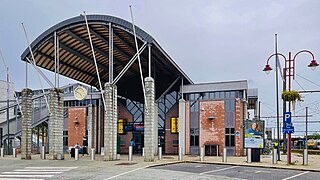
Ottignies railway station is a railway station in Ottignies-Louvain-la-Neuve, Walloon Brabant, Belgium.
The 2020–21 Belgian Division 3 was the fifth season of the division in its current format, placed at the fifth-tier of football in Belgium and the first under this name, after being renamed (Belgian) Division 3 from (Belgian) Third Amateur Division. The season was cancelled in January 2021 with just a few matches played, as measures taken by the Belgian government against the spread of COVID-19 prohibited amateur football.
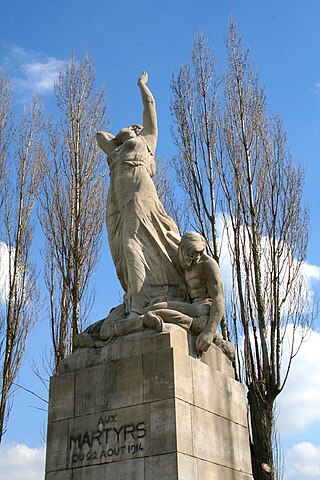
The massacre of Tamines was the summary executions and mass murder perpetrated by the German army against Belgian civilians in the town of Tamines in Namur, Belgium in the early period of the First World War.


















